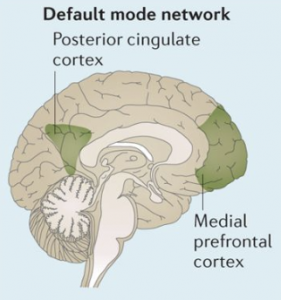
Meditation and Mind Wandering Alter Brain Network Activity Differently
By John M. de Castro, Ph.D.
“in addition to altering specific functional connectivity, meditation leads to reconfiguration of whole-brain network architecture.” – Shogo Kajimura
There has accumulated a large amount of research demonstrating that meditation practice has significant benefits for psychological, physical, and spiritual wellbeing. One way that meditation practices may produce these benefits is by altering the brain. The nervous system is a dynamic entity, constantly changing and adapting to the environment. It will change size, activity, and connectivity in response to experience. These changes in the brain are called neuroplasticity. Over the last decade neuroscience has been studying the effects of contemplative practices on the brain and has identified neuroplastic changes in widespread areas. In other words, meditation practice appears to mold and change the brain structures and connectivity, producing psychological, physical, and spiritual benefits, especially mindfulness.
Meditation practice results in a shift in mental processing. It produces a reduction of mind wandering and self-referential thinking and an increase in attention and higher-level thinking. The neural system that underlie mind wandering is termed the Default Mode Network (DMN) and consists in a set of brain structures including medial prefrontal cortex, posterior cingulate, lateral temporal cortex and the hippocampus. The neural system that underlies executive functions such as attention and higher-level thinking is termed the Central Executive Network (CEN) and includes the dorsolateral prefrontal cortex, posterior parietal cortex, and cingulate cortex. The salience network has been shown to direct attention to significant aspects of the environment. Hence the shift in thought process may well be associated with changes in the relationship of these systems.
In today’s Research News article “Spectral dynamic causal modeling of mindfulness, mind-wandering, and resting-state in the triple network using fMRI.” (See summary below or view the full text of the study at: https://www.ncbi.nlm.nih.gov/pmc/articles/PMC8893127/ ) Kim and colleagues recruited healthy adult males and had them pay attention mindfully or allow their minds to wander while having their brains scanned with functional Magnetic Resonance Imaging (fMRI).
They found that during mindfulness the central executive network had enhanced connectivity with the salience network through the default mode network. On the other hand, during mind wandering the default mode network had greater connectivity to the central executive network. This suggests that during mindfulness the neural systems enhanced attention to significant stimuli while during mind wandering the neural systems enhanced attention to internally generated thinking.
Hence, the brain’s network activity is different during different mind states.
“meditation states in long-term practitioners induced highly specific connectivity patterns of fronto-parietal and medial frontal networks relative to rest. This observation generally indicates that the executive processes of attentional control and cognitive monitoring have a specific role in supporting brain states of meditation.” – Juliana Yordanova
CMCS – Center for Mindfulness and Contemplative Studies
This and other Contemplative Studies posts are also available on Twitter @MindfulResearch
Study Summary
Kim, H. C., & Lee, J. H. (2022). Spectral dynamic causal modeling of mindfulness, mind-wandering, and resting-state in the triple network using fMRI. Neuroreport, 33(5), 221–226. https://doi.org/10.1097/WNR.0000000000001772
Objective
Functional connectivity in intrinsic brain networks, namely, the triple network, which includes the salience network, default mode network (DMN) and central executive network (CEN), has been suggested as prominent, major networks involved in human cognition and mental state–mindfulness, mind-wandering and resting-state. Despite the established roles of functional connections within and between intrinsic networks, there has been limited research on the effective connectivity of mindfulness, mind-wandering and resting-state using the triple network, as well as on their direct comparisons.
Methods
We employed spectral dynamic causal modeling to compare effective connectivity patterns across mindfulness (i.e. attention focused on physical sensations of breathing), mind-wandering (i.e. connecting thoughts) and resting-state (i.e. relaxing while remaining calm and awake) conditions using functional MRI data of healthy subjects who underwent ambulatory training by practicing mindfulness and mind-wandering (N = 59).
Results
When comparing mindfulness and mindwandering conditions, our analysis results revealed that salience network and CEN interacted depending on mindfulness or mind-wandering. When mindfulness or mind-wandering was compared to resting-state, mindfulness increased the effective connectivity from the left CEN to salience network through DMN, whereas mindwandering increased the effective connectivity from the DMN to right CEN.
Conclusion
To the best of our knowledge, this is the first study to examine possible differences in effective connectivity patterns among mindfulness, mind-wandering and resting-state using the triple network. We believe that our findings will provide deeper insights into the neural substrates of mindfulness compared to mind-wandering and resting-state.
https://www.ncbi.nlm.nih.gov/pmc/articles/PMC8893127/









